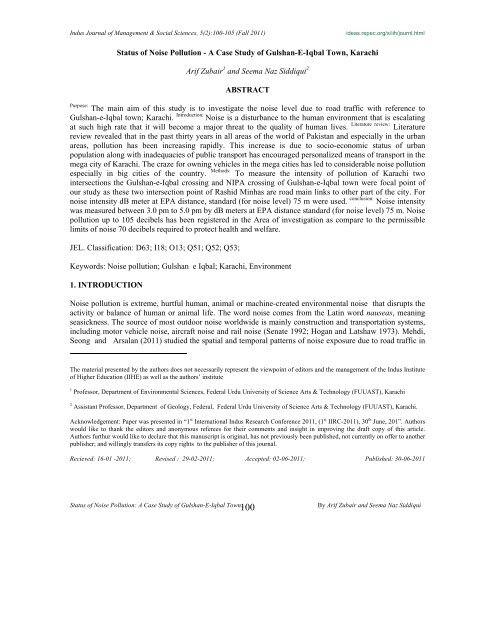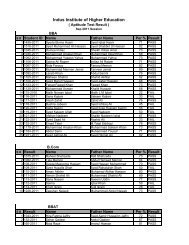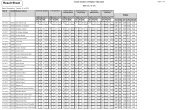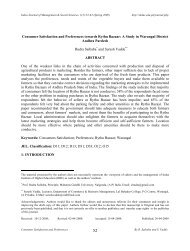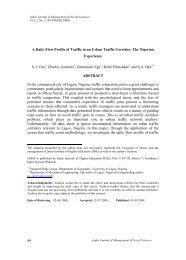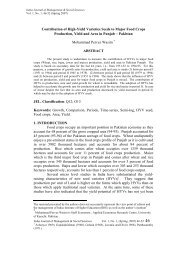9-4-Arif Zubair - FUUST-FUUST-Status of Noise Pollution
9-4-Arif Zubair - FUUST-FUUST-Status of Noise Pollution
9-4-Arif Zubair - FUUST-FUUST-Status of Noise Pollution
Create successful ePaper yourself
Turn your PDF publications into a flip-book with our unique Google optimized e-Paper software.
Indus Journal <strong>of</strong> Management & Social Sciences, 5(2):100-105 (Fall 2011)<br />
ideas.repec.org/s/iih/journl.html<br />
<strong>Status</strong> <strong>of</strong> <strong>Noise</strong> <strong>Pollution</strong> - A Case Study <strong>of</strong> Gulshan-E-Iqbal Town, Karachi<br />
<strong>Arif</strong> <strong>Zubair</strong> 1 and Seema Naz Siddiqui 2<br />
ABSTRACT<br />
Purpose:<br />
The main aim <strong>of</strong> this study is to investigate the noise level due to road traffic with reference to<br />
Gulshan-e-Iqbal town; Karachi. Introduction: <strong>Noise</strong> is a disturbance to the human environment that is escalating<br />
at such high rate that it will become a major threat to the quality <strong>of</strong> human lives. Literature review: Literature<br />
review revealed that in the past thirty years in all areas <strong>of</strong> the world <strong>of</strong> Pakistan and especially in the urban<br />
areas, pollution has been increasing rapidly. This increase is due to socio-economic status <strong>of</strong> urban<br />
population along with inadequacies <strong>of</strong> public transport has encouraged personalized means <strong>of</strong> transport in the<br />
mega city <strong>of</strong> Karachi. The craze for owning vehicles in the mega cities has led to considerable noise pollution<br />
especially in big cities <strong>of</strong> the country. Methods: To measure the intensity <strong>of</strong> pollution <strong>of</strong> Karachi two<br />
intersections the Gulshan-e-Iqbal crossing and NIPA crossing <strong>of</strong> Gulshan-e-Iqbal town were focal point <strong>of</strong><br />
our study as these two intersection point <strong>of</strong> Rashid Minhas are road main links to other part <strong>of</strong> the city. For<br />
noise intensity dB meter at EPA distance, standard (for noise level) 75 m were used. conclusion: <strong>Noise</strong> intensity<br />
was measured between 3.0 pm to 5.0 pm by dB meters at EPA distance standard (for noise level) 75 m. <strong>Noise</strong><br />
pollution up to 105 decibels has been registered in the Area <strong>of</strong> investigation as compare to the permissible<br />
limits <strong>of</strong> noise 70 decibels required to protect health and welfare.<br />
JEL. Classification: D63; I18; O13; Q51; Q52; Q53;<br />
Keywords: <strong>Noise</strong> pollution; Gulshan e Iqbal; Karachi, Environment<br />
1. INTRODUCTION<br />
<strong>Noise</strong> pollution is extreme, hurtful human, animal or machine-created environmental noise that disrupts the<br />
activity or balance <strong>of</strong> human or animal life. The word noise comes from the Latin word nauseas, meaning<br />
seasickness. The source <strong>of</strong> most outdoor noise worldwide is mainly construction and transportation systems,<br />
including motor vehicle noise, aircraft noise and rail noise (Senate 1992; Hogan and Latshaw 1973). Mehdi,<br />
Seong and Arsalan (2011) studied the spatial and temporal patterns <strong>of</strong> noise exposure due to road traffic in<br />
The material presented by the authors does not necessarily represent the viewpoint <strong>of</strong> editors and the management <strong>of</strong> the Indus Institute<br />
<strong>of</strong> Higher Education (IIHE) as well as the authors’ institute<br />
1 Pr<strong>of</strong>essor, Department <strong>of</strong> Environmental Sciences, Federal Urdu University <strong>of</strong> Science Arts & Technology (FUUAST), Karachi<br />
2 Assistant Pr<strong>of</strong>essor, Department <strong>of</strong> Geology, Federal, Federal Urdu University <strong>of</strong> Science Arts & Technology (FUUAST), Karachi.<br />
Acknowledgement: Paper was presented in “1 st International Indus Research Conference 2011, (1 st IIRC-2011), 30 th June, 201”. Authors<br />
would like to thank the editors and anonymous referees for their comments and insight in improving the draft copy <strong>of</strong> this article.<br />
Authors furthur would like to declare that this manuscript is original, has not previously been published, not currently on <strong>of</strong>fer to another<br />
publisher; and willingly transfers its copy rights to the publisher <strong>of</strong> this journal.<br />
Recieved: 16-01 -2011; Revised : 29-02-2011; Accepted: 02-06-2011; Published: 30-06-2011<br />
<strong>Status</strong> <strong>of</strong> <strong>Noise</strong> <strong>Pollution</strong>: A Case Study <strong>of</strong> Gulshan-E-Iqbal Town…<br />
100<br />
By <strong>Arif</strong> <strong>Zubair</strong> and Seema Naz Siddiqui
Indus Journal <strong>of</strong> Management & Social Sciences, 5(2):100-105 (Fall 2011)<br />
ideas.repec.org/s/iih/journl.html<br />
Karachi City, Pakistan, and found that levels <strong>of</strong> noise were generally higher during mornings and evenings<br />
for the reason that <strong>of</strong> the commuting pattern <strong>of</strong> Karachi inhabitants. Results <strong>of</strong> this study found the average<br />
value <strong>of</strong> noise levels to be over 66 dB, which possibly will cause serious annoyance according to the World<br />
Health Organization (WHO) outdoor noise guidelines. Maximum peak noise was over 101 dB, which is close<br />
to 110 dB, the level that can cause possible hearing impairment according to the WHO guidelines. It shows<br />
that noise pollution is not an environmental problem set aside for developed countries, but occurs in<br />
developing countries as well. For this cause, steps are required to reduce noise levels caused by road traffic.<br />
The major factors, which contributed towards all forms <strong>of</strong> pollution in Karachi, are mainly population,<br />
industries, seaport, road, rail and air transport, neighborhood and recreational noise. As noise <strong>Pollution</strong> is<br />
unwanted sound that introduce into our daily activities. No one on earth can escape the sounds <strong>of</strong> noise, an<br />
unwanted disturbing sound that causes a nuisance in the eye <strong>of</strong> the beholder. Same problem exist in<br />
developing and developed countries, which are supported from Duerden (1970), Julii, Jones, Batman and<br />
Lovett (1985), Khoshoo (1991) Rajvanshy and Goel (1987).<br />
These conditions forced us to undertake this study and for that, Gulshan-e-Iqbal is selected for the same<br />
considering its prime location, area and population. Attempt was made to set standards for some <strong>of</strong> the most<br />
major sources <strong>of</strong> noise, which <strong>of</strong>ten are unable to monitor. The following areas required to be investigated in<br />
some detail, transportation, natural-effects, sleeps, hearing damage and physiological effects.<br />
2. EXPERIMENTAL<br />
2.1 Study Area<br />
Gulshan-e-Iqbal town is largest town <strong>of</strong> Karachi. It is located in the center <strong>of</strong> the city covering an area <strong>of</strong> 26<br />
sq. km with 13 union council. The population <strong>of</strong> the town is approximately 1.5 million as per last census (see<br />
Fig.1). Two intersection i.e. Gulshan-e-Iqbal crossing and NIPA crossing <strong>of</strong> Gulshan-e-Iqbal town were focal<br />
point <strong>of</strong> our study as these two are intersection point <strong>of</strong> Rashid Minhas road main links to other part <strong>of</strong> the<br />
city. <strong>Noise</strong> intensity was measured between 3.0 pm to 5.0 pm by dB meters at EPA distance standard (for<br />
noise level) 75 m. Following observation ware recorded shown in Table 1 - 4. To study the whole area at<br />
particular intersection we have established the various points (shown Fig 2-3) based on the importance <strong>of</strong><br />
traffic flow endangering the domestic population.<br />
<strong>Status</strong> <strong>of</strong> <strong>Noise</strong> <strong>Pollution</strong>: A Case Study <strong>of</strong> Gulshan-E-Iqbal Town…<br />
101<br />
By <strong>Arif</strong> <strong>Zubair</strong> and Seema Naz Siddiqui
Indus Journal <strong>of</strong> Management & Social Sciences, 5(2):100-105 (Fall 2011)<br />
ideas.repec.org/s/iih/journl.html<br />
Table 1: Traffic mode volume or density (Nipa Intersection)<br />
Points Car% M/Cycle% Rickshaw% Mini Bus% Bus% Truck%<br />
A 41.9 34.9 11.6 7.9 1.5 2.2<br />
B 42.6 43.3 6.7 4.7 1.2 1.6<br />
C 49.0 30.8 11.9 4.9 1.2 2.0<br />
D 48.0 34.6 9.8 4.0 1.6 2.0<br />
E 47.3 29.5 10.2 9.5 1.4 1.9<br />
F 31.6 33.5 12.6 18.9 2.7 0.6<br />
H 49.9 37.0 6.9 2.5 0.5 2.9<br />
I 47.5 37.8 6.5 9.5 0.6 3.7<br />
<strong>Status</strong> <strong>of</strong> <strong>Noise</strong> <strong>Pollution</strong>: A Case Study <strong>of</strong> Gulshan-E-Iqbal Town…<br />
102<br />
By <strong>Arif</strong> <strong>Zubair</strong> and Seema Naz Siddiqui
Indus Journal <strong>of</strong> Management & Social Sciences, 5(2):100-105 (Fall 2011)<br />
ideas.repec.org/s/iih/journl.html<br />
Table 2: <strong>Noise</strong> Level (Nipa Intersection)<br />
Point Maximum <strong>Noise</strong> level Minimum <strong>Noise</strong> level Average <strong>Noise</strong> level<br />
A 100.2 65.8 77.8<br />
B 100.1 78.4 82.9<br />
C 99.8 78 83.9<br />
D 98.8 75.7 83.0<br />
E 99.7 72.4 82.8<br />
F 105 68.8 82.4<br />
G 99.7 79.5 83.1<br />
H 102.6 70.1 82.0<br />
I 99 72.1 82.8<br />
Table 3: Traffic mode volume or density (Gulshan Intersection)<br />
Points Car% M/Cycle% Rickshaw% Minibus% Bus% Truck%<br />
A 44.3 29.0 21.5 2.04 0.60 2.20<br />
B 46.7 33.6 6.7 7.3 1.4 4.1<br />
C 35.8 43.0 7.7 7.6 1.1 4.6<br />
D 44.3 32.6 17.2 2.8 1.0 1.9<br />
Table 4: <strong>Noise</strong> Level (Gulshan Intersection)<br />
Point Maximum <strong>Noise</strong> level Minimum <strong>Noise</strong> level Average <strong>Noise</strong> level<br />
A 86.2 75.3 83.9<br />
B 100.4 72 82.4<br />
C 100.2 74 83.3<br />
D 100.4 76 86.6<br />
<strong>Status</strong> <strong>of</strong> <strong>Noise</strong> <strong>Pollution</strong>: A Case Study <strong>of</strong> Gulshan-E-Iqbal Town…<br />
103<br />
By <strong>Arif</strong> <strong>Zubair</strong> and Seema Naz Siddiqui
Indus Journal <strong>of</strong> Management & Social Sciences, 5(2):100-105 (Fall 2011)<br />
ideas.repec.org/s/iih/journl.html<br />
Fig 2- Map <strong>of</strong> NIPA Intersection<br />
Fig 3- Map <strong>of</strong> Gulshan Intersection<br />
3. DISCUSSION<br />
The noise level monitored at NIPA interaction is low as compared to Gulshan-e-Iqbal intersection due to<br />
following two reasons:<br />
The flow <strong>of</strong> the traffic is quite smooth and fast as compared to Gulshan-e-Iqbal intersection due to two<br />
bridges nearby, which facilitates the flow. However at Gulshan-e-Iqbal intersection the traffic light controls<br />
the flow <strong>of</strong> traffic as a result there is always crowed <strong>of</strong> vehicles at one point or another, which contributes lot<br />
<strong>of</strong> noise <strong>of</strong> pollution all time. Motor cycles and Mini buses are main contributor towards high rates <strong>of</strong> noise.<br />
<strong>Noise</strong> intensity is measured in decibel units. Subjected to 45 Decibels <strong>of</strong> noise, the average person cannot<br />
sleep. At 120 decibels, the ear registers pain but hearing damage begins at a much lower level about 85<br />
decibels. The duration <strong>of</strong> the exposure is also important. Apart from hearing loss, such noise can cause lack<br />
<strong>of</strong> sleep, irritability heartburn, indigestion, ulcers, high blood pressure and possibly heart disease.<br />
4. CONCLUSION<br />
The result <strong>of</strong> the study emphasizes:<br />
• There is an urgent need for an alternative public transport system on selected roads with a better<br />
management <strong>of</strong> transport system.<br />
• The Government should strictly enforce traffic rules.<br />
• The Government should equip vehicles with approach horns and silencers.<br />
<strong>Status</strong> <strong>of</strong> <strong>Noise</strong> <strong>Pollution</strong>: A Case Study <strong>of</strong> Gulshan-E-Iqbal Town…<br />
104<br />
By <strong>Arif</strong> <strong>Zubair</strong> and Seema Naz Siddiqui
Indus Journal <strong>of</strong> Management & Social Sciences, 5(2):100-105 (Fall 2011)<br />
ideas.repec.org/s/iih/journl.html<br />
• Environment protection agency should determine the limit <strong>of</strong> noise to protect public health and welfare<br />
to set noise emission standard for major source <strong>of</strong> noise in the environment.<br />
• The City Government <strong>of</strong> Karachi should discourage the commercial activity at one part <strong>of</strong> the city.<br />
REFERENCES<br />
Duerden. C. 1970. <strong>Noise</strong> Abatement. London. Butterworth & Co (Publishers) Ltd.<br />
Hogan, C. Michael and Gary L. Latshaw. 1973. The relationship between highway Planning and Urison<br />
Specialty conference, May 21-23, Chicago, Illinois: American Society <strong>of</strong> Civil Engineers. Urban<br />
Transportation Division.<br />
Juli S.Brainard, Andrew P.Jones, Ian J.Batman and Andrew A.Lovett. 1985. Modeling Environmental<br />
Equity: Exposure to Environmental Urban <strong>Noise</strong> <strong>Pollution</strong>.<br />
Khoshoo T.N. 1991. Environmental concerns and Strategies. New Dehli: Asish Publishing House.<br />
Mehdi, Kim M, J.C. Seong and M.H. Arsalan. 2011. Spatio-temporal patterns <strong>of</strong> road traffic noise pollution<br />
in Karachi, Pakistan. Environment International, 37(1): 97-104 (January). Epub 2010 Sep 19.<br />
Source: NED University <strong>of</strong> Engineering & Technology, Karachi 75270, Pakistan.<br />
Rajvanshy.P.S and M.M. Goel.1987. Study and <strong>Status</strong> <strong>of</strong> Environmental Consciousness in the Planned City<br />
Jaipur, Jaipur: Rajasthan <strong>Pollution</strong> Prevention and Control Board.<br />
Senate. 1972. <strong>Noise</strong> <strong>Pollution</strong> and Abatement Act <strong>of</strong> 1972. S. Rep. No. 1160, 92nd Cong. 2nd session.<br />
Senate Public Works<br />
Committee.www.associatepublisher.com/e/n/no/noise_health_effects.htm<br />
<strong>Status</strong> <strong>of</strong> <strong>Noise</strong> <strong>Pollution</strong>: A Case Study <strong>of</strong> Gulshan-E-Iqbal Town…<br />
105<br />
By <strong>Arif</strong> <strong>Zubair</strong> and Seema Naz Siddiqui


